Embracing Coastal Elegance in Home Decor
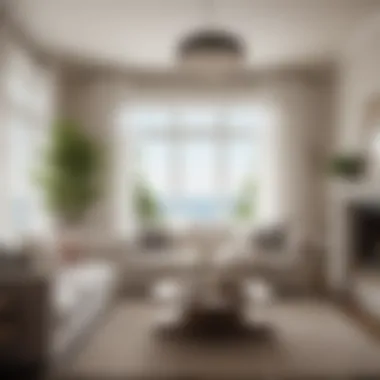
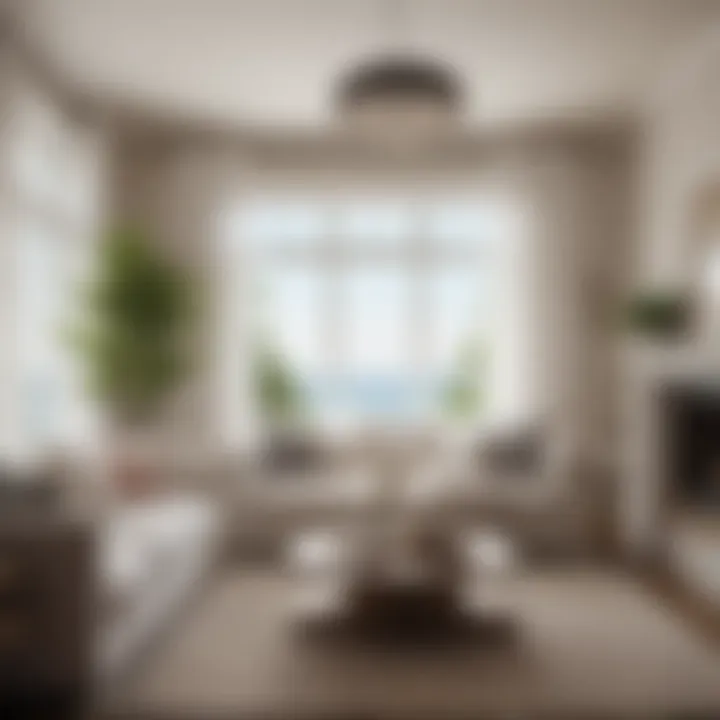
Intro
Design Inspiration
Current Interior Design Trends
Emerging trends often showcase reclaimed materials, focusing on sustainability. Homeowners increasingly seek ways to incorporate eco-friendly practices in their decor choices. By selecting vintage or upcycled items, they add character while minimizing environmental impacts. Sustainability complements the essence of coastal living, reflecting respect for nature.
Color Palettes and Their Effects
- Soft white
- Sky blue
- Seafoam green
- Sandy beige
- Driftwood gray
These colors evoke a sense of peace and create a tranquil atmosphere. The careful balancing of these shades is essential, as too much contrast can disrupt the serene aesthetic. Soft accent colors, such as coral or muted yellows, can also be introduced to add warmth and interest without overwhelming the space.
"Creating a living space that embodies the essence of coastal living helps foster a deep connection to nature and encourages relaxation."
Natural light amplifies the effects of these color palettes. Large windows, light sheer fabrics, and mirrors can effectively brighten spaces. Maximizing light not only enhances decor but also establishes a more significant sense of openness, which is vital in coastal design.
Entertaining Ideas
Themed Party Concepts
Natural elements such as bamboo or linen tablecloths can elevate the decor while blending seamlessly with the coastal theme. Seasonal flowers sourced locally can further enhance the space and bring fresh scents indoors.
Menu Planning and Recipes
Planning a menu that resonates with the coastal theme is equally important. Focus on fresh, seasonal ingredients that reflect the essence of the ocean. Dishes such as grilled seafood, vibrant salads, and light desserts can create a memorable dining experience. Consider incorporating local flavors or seafood varieties that are not only delicious but also sustainable options.
Using simple presentation techniques, such as serving dishes on wooden boards or glass platters, can enhance visual appeal. Consider this sample menu for inspiration:
- Appetizer: Shrimp cocktail with tangy dipping sauce
- Main course: Grilled salmon with a lemon-dill sauce
- Side dish: Quinoa salad with cucumbers and herbs
- Dessert: Key lime pie or coconut sorbet
By merging decor with thoughtful meal planning, hosts can create a cohesive, elegant experience that embodies the spirit of coastal living, ensuring guests feel the warmth and charm inherent in this style.
Defining the Aesthetic
Core to the aesthetic are the principles of simplicity and a connection to nature. Decoration should be minimal yet impactful, showcasing the beauty of natural textures and forms. Coastal elegance achieves this by incorporating elements that remind us of the shoreline, such as driftwood, seashells, and marine-inspired artworks.
Historical Influences on Coastal Design
The roots of coastal design can be traced back to regions that are close to water bodies. This aesthetic evolved as societies began to prioritize living spaces that reflected their geographical surroundings. Historical influences range from the light, airy homes of New England fishermen to the sophisticated beach houses of California.
Core Elements of Coastal Elegance
The core elements of coastal elegance are essential for understanding how to achieve this distinct aesthetic in any space. By carefully selecting specific design aspects, homeowners can create an environment that encapsulates the tranquility of coastal living while maintaining a refined appearance. Key components such as color palettes, textures, materials, and furniture choices not only contribute to the beauty of a space but also create an atmosphere that promotes relaxation and peace. The importance of these elements cannot be overstated; they can transform an ordinary space into a sophisticated retreat.
Color Palettes: The Sea and Beyond
Soft Blues and Greens
Soft blues and greens are among the most defining colors in coastal elegance. They reflect the colors found in the ocean and sky, creating a serene backdrop for the decor. The key characteristic of these shades is their ability to instill calmness. They evoke feelings of tranquility and openness, making them a popular choice for walls and furnishings.
These colors work well in various areas like living rooms or bedrooms. One unique feature of soft blues and greens is their versatility. They can easily complement other shades while maintaining a cohesive theme. However, one has to be cautious. Too much of these shades may create a monotonous effect if not balanced with other colors or textures.
Neutral Tones
Neutral tones play a significant role in coastal elegance, serving as the perfect base for more vibrant colors. Shades like beige, taupe, and soft whites can create a tranquil atmosphere, making spaces feel light and airy. The main benefit of neutral tones is their ability to harmonize with various design elements, which allows for a broader creative scope.
These tones lead to an inviting ambiance that enhances natural light in rooms. Importantly, neutral shades are timeless. They withstand changing trends, making them a solid choice for anyone looking to achieve lasting decor. The drawback is that relying solely on neutrals might make a space feel bland or uninspired unless supplemented with accents.
Accent Colors
Accent colors bring life into coastal design and can denote personality within a decor scheme. Hues like coral, sunny yellow, or rich turquoise can punctuate a neutral backdrop, creating focal points that draw attention. The key feature of accent colors is their ability to energize spaces without overwhelming them.
Using these colors in accessories, artwork, or textiles can enhance the overall aesthetic. The unique advantage lies in their capacity to reflect seasonal changes, offering a fresh look throughout the year. A challenge, however, is achieving the right balance. Too many bold accents can clash with the overall theme, undermining the cohesive nature of coastal elegance.
Textures That Evoke the Coast
Natural Fibers
Natural fibers such as cotton, jute, and linen are vital in creating the coastal elegance theme. These materials evoke a sense of warmth and familiarity. Their key characteristic is durability combined with comfort, making them ideal choices for upholstered items like sofas and cushions. Exploring natural fibers can evoke memories of sandy beaches and summer breezes, contributing to the overall vibe.
One significant advantage is their eco-friendliness. Natural materials typically have less environmental impact compared to synthetic options. However, proper care is essential, as natural fibers may deteriorate faster when exposed to excessive moisture or sunlight.
Weathered Woods
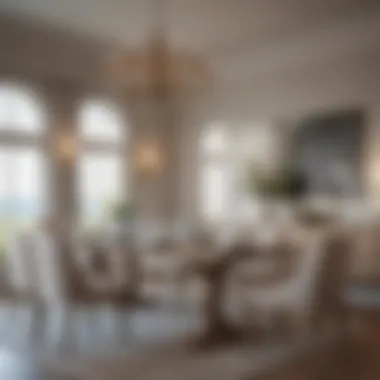
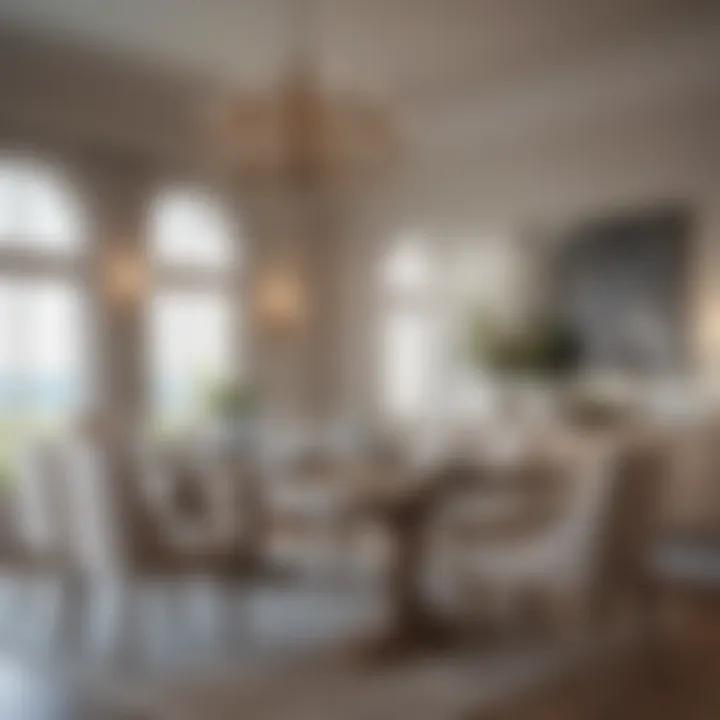
Weathered woods embody the charm and rustic quality of coastal living. The distinctive, aged appearance of weathered wood introduces character to a space. It often brings memories of driftwood and seaside strolls, making it integral to coastal decor.
The primary benefit of weathered woods is their ability to convey a laid-back elegance. Using reclaimed or weathered wood in furniture or flooring can create a timeless appeal. However, care must be taken, as the finish may require maintenance to preserve its look and resist damage.
Smooth Stones
Smooth stones add a natural element to coastal decor, offering organic shapes and textures that can serve as both accessories and materials. The main advantage of incorporating smooth stones is their innate connection to the beach, where they often wash ashore, smoothed by waves. This characteristic makes them appealing choices for decorative accents and landscaping.
They can be used in various ways, from garden paths to decorative bowls. However, one must consider their weight and placement. While they are durable, heavy stones require stable surfaces to avoid accidental damage or movement. The strategic use of smooth stones can enhance the coastal theme while reflecting a sophisticated yet natural elegance.
Furniture Selection for Coastal Spaces
The right furniture can enhance the overall mood of a room, promoting relaxation while inviting a sense of calmness and connection to nature. Naturally, high-quality materials and craftsmanship are essential; durability without sacrificing design is key in achieving this balance. Consider choices that are versatile, offer comfort, and can adapt to the space's needs, especially in multifunctional areas.
"In coastal design, the right furniture not only serves a purpose, but also reinforces the aesthetic narrative of the space."
Choosing the Right Pieces
When it comes to selecting individual furniture pieces for coastal spaces, the focus should be on comfort, scale, and coherence with the overall theme. Lightweight materials such as wicker or rattan are ideal, as they suggest a relaxed ethos synonymous with coastal living. Additionally, translucent elements like glass accentuate the flow of light, which is vital in connecting indoors with outdoors.
Opt for larger furniture items that do not overwhelm the space. Low-profile sofas and chairs create an inviting look while keeping sight lines open. A good approach may include the use of modular furniture, which allows flexibility in arrangements and can accommodate various occasions.
In addition to aesthetics, consider functionality. Select pieces that offer storage while maintaining style. Coffee tables with compartments or benches with hidden storage can add practicality and keep the space tidy. Natural wood finishes resonate well with the coastal theme, while maintaining warmth and comfort.
Incorporating Functional Design
Functional design is an essential aspect when creating coastal elegance in homes. It combines utility with aesthetic appeal and should be a guiding principle in furniture selection. Look for furniture that can serve multiple purposes, especially in smaller spaces where maximizing use is crucial.
For example, extendable dining tables are perfect for entertaining guests while keeping the space open during quiet family meals. Similarly, day beds or pull-out sofas can accommodate visitors without sacrificing comfort.
Moreover, chairs and sofas should offer easy maintenance, often characterized by removable, washable covers or fabrics that resist stains and wear. Furniture made from synthetic fibers or treated for durability can endure the humidity and frequent use associated with coastal living.
Ultimately, incorporating functional design into coastal spaces enhances the quality of life and provides a seamless blend of style and practicality. By focusing on the purpose each piece serves, homeowners can achieve a cohesive aesthetic that mirrors the elegance of coastal living.
Lighting That Complements Coastal Decor
- Natural light maximization: Utilizing natural light sources can transform a space.
- Layered lighting techniques: Combining different types of lighting creates depth and versatility.
- Complementary fixtures: Choosing the right fixtures complements your decor style rather than overpowering it.
Natural Light and Its Importance
The benefits of incorporating natural light into your design include:
- Enhanced mood: Natural light can improve one's mood and well-being.
- Energy-efficient: Utilizing daylight reduces electricity usage.
- Connection to nature: It fosters a sense of connection with the outdoors.
Therefore, consider how you can maximize natural light in your space, such as opting for sheer window treatments or placing reflective surfaces strategically.
Types of Lighting Fixtures
Soft Ambient Lighting
Soft ambient lighting is crucial for fostering a relaxing environment in coastal spaces. These fixtures provide a gentle illumination that creates a cozy, inviting atmosphere.
Key characteristics of soft ambient lighting include:
- Warm glow: It offers a warm, diffused light.
- Versatile applications: This type of lighting is adaptable to various rooms including living spaces and bedrooms.
- Enhances texture: Soft lighting highlights the natural textures found in coastal decor, such as woven fibers and weathered wood.
Soft ambient lighting is a popular choice for its capacity to create a tranquil environment. If overused, however, it may lead to spaces appearing dim. Therefore, it is important to balance this type of lighting with other lighting sources.
Statement Fixtures
Statement fixtures serve as focal points within a room and can add a unique character to coastal decor. These fixtures come in various forms, including oversized chandeliers or striking pendant lights.
Key characteristics of statement fixtures include:
- Bold designs: They are often crafted with artistic flair.
- Eye-catching: Statement fixtures capture attention, drawing the eye to them.
- Versatility in style: They can range from modern to rustic, fitting well in a coastal setting.
While statement fixtures are great for making a design statement, they can sometimes detract from the overall decor if not chosen wisely. They should complement, not compete with, the other elements of the space.
In summary, striking the right balance between soft ambient lighting and statement fixtures is vital in achieving the desired coastal elegance effect.
Integrating Natural Elements
Bringing the Outside In
One effective way to integrate natural elements is by bringing the outside in. This concept involves creating a seamless transition between natural outdoor environments and indoor spaces. Large windows or glass doors can connect interior spaces to the outdoors, allowing ample natural light to enter. This openness provides a sense of spaciousness, enhancing the overall aesthetic.
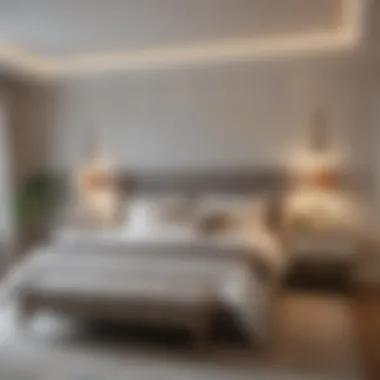
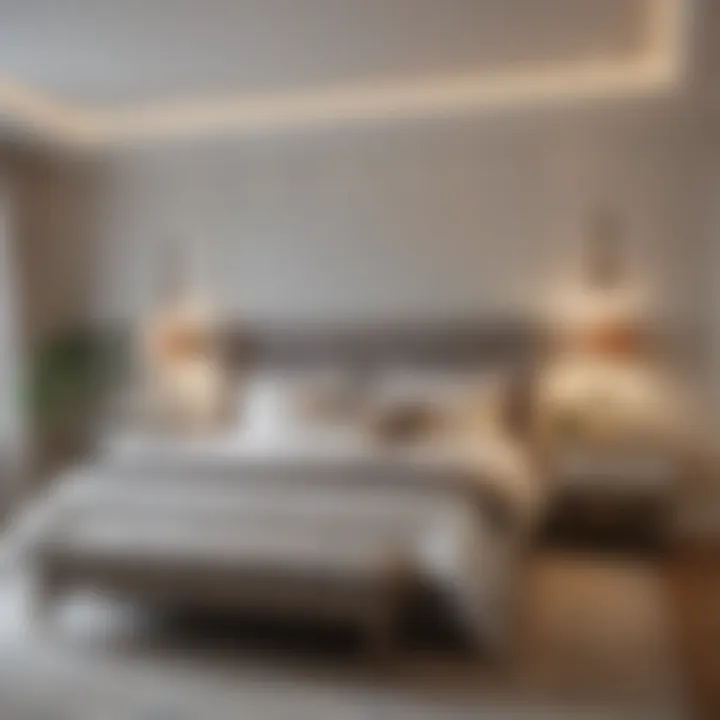
Natural materials play a crucial role here. Using wood, stone, and other organic textures evokes a sense of the coastal landscape, reinforcing the outdoor connection. Consider adding features like stone wall accents or wooden beams to mimic the ruggedness of the coast. The goal is to create an inviting atmosphere that feels like a natural extension of the outside world.
Plant Selection for Coastal Elegance
Choosing the right plants is essential for achieving a coastal elegance aesthetic. Plants not only purify the air, but they also add life to the decor. Selecting the right species can enhance the theme and create a cohesive environment.
Coastal Plants
Coastal plants are a perfect choice for achieving this aesthetic. They are typically drought-resistant and adapted to the coastal climate. Their natural resilience often means they require less maintenance, which is a significant advantage for busy homeowners.
A key characteristic of coastal plants is their ability to thrive in sandy soils and salt water. For instance, plants like sea oats and beach grasses are excellent for their hardy nature and attractive appearance. They can introduce texture and movement in spaces, echoing the gentle sway of coastal environments.
However, while coastal plants have many benefits, they can also present challenges. Depending on the local climate, some may not be suitable for indoor growth. Thus, careful selection is necessary to ensure the plants thrive and contribute positively to the decor.
Indoor Plants
Indoor plants offer a versatile option that adds to the coastal elegance theme. They can revitalise any space with color and greenery. Selecting species that do well indoors helps maintain a thriving atmosphere within the home.
A key feature of indoor plants is their adaptability to different light conditions, making them ideal for various areas of the home. Plants such as snake plants and pothos thrive in varying light levels and require minimal care, which is ideal for those with a busy lifestyle.
The main advantage of indoor plants is their ability to enhance air quality and promote a healthier living environment. However, it’s important to consider the specific care needs, as some indoor plants require more attention than others. Choosing low-maintenance options allows for easy integration into home decor without compromising the overall coastal theme.
By thoughtfully integrating natural elements, including plants, into decor, homeowners can create stunning spaces that resonate with the coastal elegance aesthetic.
Color Application Techniques
Walls and Ceilings
When it comes to walls and ceilings in coastal decor, the choice of color sets the foundational tone for a space. Light colors such as whites and soft pastels contribute to a feeling of airiness and openness. These shades reflect natural light, making rooms feel larger and more inviting. Choosing a soft blue or green for the ceiling can mimic the sky and sea, providing a subtle connection to the coastal theme.
Considerations:
- When selecting paint finishes, opt for matte or eggshell options. These can offer a soft glow while minimizing glare.
- It is also important to consider how colors change under different lighting throughout the day. This can greatly affect the final appearance and mood of a room.
Accents and Accessories
Accents and accessories offer opportunity to infuse more distinct colors into a coastal space. Here, the use of bolder hues can create focal points that draw the eye and enhance the overall design narrative. Items such as cushions, artwork, and decorative pieces can be used for this purpose.
Tips for effective application:
- Layer different colors through textiles and artworks. For example, rich blues or coral can serve as a striking contrast against lighter walls.
- Use natural materials, like woven baskets or ceramics, as they can soften vibrant colors and maintain a cohesive look.
- It's important to maintain balance, however. Too many bold colors can overwhelm a space. Aim for a few standout pieces that complement the chosen color palette.
"The key to coastal elegance in decor is not just in choosing colors, but in how they interact with each other and the surrounding elements."
Decorative Accessories for Impact
The right accessories can create focal points within a room, guide the eye, and evoke a sense of place. Moreover, they support the balance between functionality and style, allowing homeowners to include personal touches that reflect their taste while maintaining the elegance inherent to coastal designs.
When considering decorative accessories, it is important to keep in mind the color scheme, texture, and scale. Accessories should blend seamlessly into the space while also standing out enough to make an impact. This balance not only enhances visual interest but also reinforces the soothing yet refined character that coastal style embodies.
Choosing Art and Prints
Art and prints provide an opportunity to express individuality and enhance the coastal theme. Seascapes, abstract representations of waves, and marine life illustrations can encapsulate the essence of coastal elegance. It’s important to choose pieces that resonate personally while aligning with the overall decor. Large art pieces can work well as statement walls, while smaller prints can be arranged in a gallery style, bringing dynamism into the space.
Textiles That Enhance Elegance
Textiles contribute to the overall comfort and atmosphere of coastal spaces. They serve as soft accents that invite relaxation and create warmth. Proper use of textiles can highlight the lightness and simplicity associated with coastal decor.
Cushions and Throws
Cushions and throws can deeply enrich the comfort level of a home. They act as soft accessories that complement larger furniture pieces and introduce texture. One specific aspect of cushions is their versatility in size and pattern, making it easy to mix and match.
The key characteristic of cushions and throws is their ability to transform a space. By using various fabrics—like linen or cotton—that reflect the coastal theme, homeowners can enhance harmony within their decor. Cushions with subtle nautical patterns or soft hues may provide the desired effect without overwhelming the room.
A significant benefit of incorporating cushions and throws is their easy maintenance. Unlike larger elements, these accessories can be quickly changed out for seasonal updates. However, it is essential to consider the impact of color choices. Dark-colored throws may absorb heat and create a contrasting effect in a light, airy room.
Rugs and Curtains
Rugs and curtains play a vital role in grounding the coastal decor. These elements work together to delineate spaces and add layers of warmth. Choosing the right rugs can define areas within open floor plans, while curtains can soften natural light, influencing the mood of the room.
The key characteristic of rugs lies in their variety of textures and designs. A natural fiber rug can offer an organic appeal, complementing the beachy elements of coastal decor. Curtains, on the other hand, can create continuity in color while adding depth through various fabrics.
Rugs and curtains have unique features that can either enhance or detract from the overall aesthetic. For instance, heavier drapes might obstruct light, which could go against the playful brightness of coastal spaces. On the other hand, sheer curtains can filter light gently, maintaining an open and luminous atmosphere.
Sustainability in Coastal Decor Choices
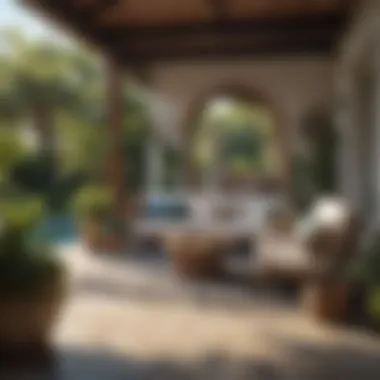

Sustainability is increasingly becoming a priority in interior design, and coastal decor is no exception. In the context of coastal elegance, sustainability not only enhances the visual appeal but also preserves the environment. Homeowners, designers, and enthusiasts are called to consider the impact of their choices on natural landscapes, especially given the close relationship coastal decor has with nature. Utilizing sustainable materials and practices can reflect a commitment to preserving the very essence that coastal design embodies.
Incorporating sustainability into decor choices provides benefits that extend beyond aesthetics. For instance, eco-friendly materials often boast durability, offering longevity without compromising style. Moreover, using sustainable resources can lead to a healthier living environment by reducing exposure to harmful chemicals typically found in conventional products.
When choosing decor for coastal elegance, consider how sustainability influences multiple aspects, such as:
- Material selection: Opting for naturally sourced materials contributes to environmental protection while aligning with the coastal theme.
- Waste reduction: Embracing practices that minimize waste helps ensure that decor choices do not add to environmental concerns.
- Supporting local economies: Seeking out locally sourced products not only reduces carbon footprints but also supports community artisans.
Through mindful considerations, homeowners can create spaces that reflect both elegance and ecological responsibility.
Eco-Friendly Materials
In the realm of coastal decor, the use of eco-friendly materials is paramount. Materials such as reclaimed wood, bamboo, and organic textiles are excellent choices that embody the principles of sustainability. Reclaimed wood, especially, infuses warmth and character into spaces, making it ideal for furniture or accent pieces.
Bamboo is another excellent option. It is a highly renewable resource that grows quickly and requires fewer pesticides than traditional woods. Additionally, organic textiles, such as those made from cotton or linen, are free from harmful chemicals. These materials not only contribute to a safer home environment but also align with the serene aesthetics of coastal elegance.
Choosing eco-friendly materials provides:
- Reduced ecological impact through sustainable harvesting methods.
- Aesthetic versatility that complements coastal decor styles.
- Improved indoor air quality, as many organic options do not release volatile organic compounds (VOCs).
Sustainable Practices in Design
Employing sustainable practices in design is essential for creating coastal elegance that is mindful of environmental impact. This can involve various strategies that promote sustainability while enhancing the aesthetic appeal of spaces.
Incorporating energy-efficient lighting is one practice that reduces energy consumption. Opting for LED fixtures not only provides adequate lighting but also supports an eco-friendly ethos. Additionally, maximizing natural light can lessen reliance on artificial sources that consume energy.
Another practice to consider is the strategic use of decor elements. For instance, selecting pieces that are designed for longevity and timelessness avoids the need for frequent replacement. This could mean investing in high-quality, classic furniture and decorative items that will withstand changing trends.
Additionally, consider incorporating multi-functional furniture. Pieces that serve more than one purpose reduce the need for additional items, minimizing clutter and waste.
In essence, employing sustainable practices in design leads to a home that is not only elegant but also a responsible steward of ecological principles. This holistic approach ensures that coastal elegance can truly reflect a commitment to both beauty and sustainability.
"Designing with sustainability in mind transforms spaces into reflections of both elegance and environmental responsibility."
Creating Coastal Elegance in Different Spaces
Creating coastal elegance within various living spaces is key to achieving a harmonious atmosphere. Each room within a home serves a distinct purpose and conveys a unique energy. The challenge lies in cohesively integrating the coastal theme throughout these spaces while retaining functionality.
Understanding how to adapt coastal elegance principles to different rooms enhances both the visual appeal and the comfort of the home. This approach allows homeowners to create environments that resonate with tranquility and sophistication. Moreover, the careful selection of materials, colors, and furnishings tailored for each area can uplift daily living experiences.
Living Rooms and Lounges
In living rooms and lounges, the coastal aesthetic can be expressed through the use of light, airy color schemes and soft textures. Soft blues, neutral whites, and sandy beiges work together to evoke the essence of the beach. A key element is the furniture choice; opt for pieces that are inviting but refined. Consider slipcovered sofas in durable fabrics, allowing for both comfort and easy maintenance.
Accessories should reflect coastal life, perhaps through artwork depicting seascapes or marine life. Additionally, chandeliers or table lamps inspired by natural elements can provide a warm ambiance during evenings.
Dining Areas and Kitchens
Dining areas offer an opportunity for vibrant coastal charm. A large wooden dining table, especially one that shows wear and grain, can bring an organic feel to the space. Chairs with woven seats can enhance this aesthetic.
In kitchens, open shelving displaying dishware in nautical colors can add charm. Consider backsplashes with sea glass tiles that reflect light beautifully. Choose curtains that allow natural light to flow freely while providing a soft contrast to cabinets.
Bedrooms and Relaxation Areas
For bedrooms, creating a serene retreat is essential. Soft linens in shades of aqua or pale coral can transform the bed into a tranquil oasis. Incorporate natural materials like jute rugs or rattan furniture to enhance the coastal feel.
To maximize relaxation, consider layering lighting options such as bedside lamps and dimmable ceiling fixtures. Wall art featuring oceanic themes can evoke a sense of calm, providing a constant reminder of the coast.
Outdoor Spaces
Outdoor areas should mimic the peaceful feel found inside the home. Begin with comfortable seating arrangements that invite long conversations. Use weather-resistant fabrics in soothing colors, keeping the theme consistent.
Incorporating natural elements, like driftwood-sculpted furniture or potted coastal plants, enhances the connection to nature. String lights can add a cozy glow during evenings, completing the inviting atmosphere of coastal elegance.
Integrating coastal decor into every room transforms the entire home into a cohesive sanctuary, reflecting both inner peace and sophistication.
By maintaining these elements across various spaces, a unified coastal elegance is created, allowing residents to fully embrace the tranquility and charm of coastal living.
Ending: The Lasting Appeal of Coastal Elegance
A key component of coastal elegance is its focus on sustainability. The trend towards eco-friendly materials and practices supports not just aesthetic value but also environmental responsibility. Homeowners today are increasingly aware of their impact on the planet and actively seek decor options that promote sustainability. In this manner, coastal elegance serves as a bridge between beauty and ecological consciousness.
"Embracing coastal elegance means not just styling your home but creating a lifestyle that prioritizes nature and serenity."
Timelessness and Trends
Timelessness in coastal elegance is manifested through its predominant features, such as soft hues and organic textures. These elements create a backdrop that allows for occasional trend infusions without compromising the overall aesthetic. As trends fluctuate, coastal elegance assures a haven of steadiness that remains appealing.
Current design trends, like integrating vintage or reclaimed materials, resonate well with the coastal decor ethos. Furniture pieces that showcase weathered finishes or artisanal designs complement the overall ambiance. Moreover, as homeowners become more discerning in their choices, investing in quality over quantity becomes paramount. This trend aligns perfectly with the coastal aesthetic, where every piece tells a story.
Homeowners interested in this decor style should also consider how modern innovations influence coastal themes. Intelligent technology can find a home in even the most relaxed of environments, enhancing both function and style. By integrating smart lighting solutions or energy-efficient designs, one can elevate a coastal space while maintaining its relaxed feel.















